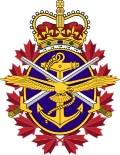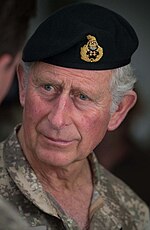Commander-in-Chief of the Canadian Armed Forces
| Commander-in-Chief of the Canadian Armed Forces | |
|---|---|
| Commandant en chef des Forces armées canadiennes | |
 Badge of the Canadian Armed Forces | |
| Canadian Armed Forces | |
| Type | Role |
| Abbreviation | C-in-C |
| Constituting instrument | Constitution Act, 1867 Letters Patent, 1947 |
| Formation | 1 July 1867 |
| First holder | Queen Victoria |
| Deputy | Chief of the Defence Staff |
The commander-in-chief of the Canadian Armed Forces (French: Commandant en chef des Forces armées canadiennes) exercises supreme command and control over Canada's military, the Canadian Armed Forces. Constitutionally, command-in-chief is vested in the Canadian monarch, presently King Charles III. Since the Letters Patent, 1947, were signed by King George VI, the governor general of Canada—presently Mary Simon—executes most of the duties of the sovereign, including in his role as commander-in-chief. Consequently, the governor general also uses the title Commander-in-Chief of the Canadian Forces. By protocol, the title used within international contexts is Commander-in-Chief of Canada.
Constitutional provisions, title, and delegation
[edit]The Constitution Act, 1867, states that "the Command-in-Chief of the Land and Naval Militia, and of all Naval and Military Forces, of and in Canada, is hereby declared to continue and be vested in the Queen."[1] However, beginning in 1904, the exercise of the duties of the commander-in-chief were delegated to the governor general of Canada, the monarch's representative in the country. The Militia Act from that year stated, "the Command-in-Chief of the Militia is declared to continue and be vested in the King, and shall be administered by His Majesty or by the Governor General as his representative." Following this, in 1905, the letters patent constituting the Office of the Governor General were amended to read: the "Letters Patent constituting the Office of the Governor General and Commander-in-Chief."
Throughout the development of the armed forces, the monarch has remained vested with command-in-chief,[2][3] while the governor general's title altered to suit the changes in the militia's structure. Following the passage of the Naval Service Act establishing the Royal Canadian Navy in 1910, the viceroy was styled Commander-in-Chief of the Militia and Naval Forces and, after the creation of the Royal Canadian Air Force in 1918, as Commander-in-Chief of the Militia and Naval and Air Forces. Following this, the Letters Patent, 1947, issued by King George VI, referred to the "Office of Governor General and Commander-in-Chief in and over Canada."[4][5] In 1968, following the unification of the Royal Canadian Navy, the Canadian Army, and the Royal Canadian Air Force, the commander-in-chief became the most senior officer of the Canadian Armed Forces.
As all executive power is legally reposed in the Crown, the role of commander-in-chief is the only constitutional means by which decisions are made over the deployment and disposition of the Canadian Armed Forces.[6] Under the Westminster system's conventions of responsible government, the cabinet—which advises the sovereign or his viceroy on the exercise of the executive powers—generally exercises the Crown prerogative powers relating to the Canadian forces.[6][7] Still, all declarations of war are issued with the approval, and in the name, of the monarch and must be signed by either the sovereign or the governor general, as was done with the proclamation that declared Canada at war with Nazi Germany, issued on September 10, 1939; it stated: "Whereas by and with the advice of Our Privy Council for Canada, We have signified Our Approval for the issue of a Proclamation in the Canada Gazette declaring that a State of War with the German Reich exists and has existed in Our Dominion of Canada as and from the tenth day of September, 1939."[8]
In exercising the duties of commander-in-chief, the governor general appoints the chief of the Defence Staff, as well as royal colonels-in-chief of Canadian regiments (save for the monarch himself); approves new military badges and insignia (except for those bearing St Edward's Crown, which may only be sanctioned by the sovereign); visits Canadian forces personnel within Canada and abroad; bestows honours, decorations, and medals; and signs commission scrolls.[4] Since 2000, the governor general also awards the Commander-in-Chief Unit Commendation to units in the Canadian Forces and allied militias that have performed extraordinary deeds or activities in highly hazardous circumstances in active combat. An insignia pin is presented to members and the unit receives a scroll and may fly a special banner.[9][10]
Governor general's rank insignia
[edit]According to Canadian Forces Dress Instructions, the governor general may wear the uniform and corresponding cap/hat badge of a flag/general officer, with a special flag/general officer sleeve braid embellished with the governor general's badge, and a large embroidered governor general's badge on the shoulder straps or boards, facing forward.[11]
| Royal Canadian Navy | Canadian Army | Royal Canadian Air Force | |||
|---|---|---|---|---|---|

|

|

|

|

|

|
| Board | Sleeve | Board | Sleeve | Board | Sleeve |
Commanders-in-chief of the Canadian Armed Forces
[edit]| Year | Sovereign | Year | Represented by Governor General |
|---|---|---|---|
| Commanders-in-Chief of the Canadian Land and Naval Militia | |||
| 1867 – 1901 |  Queen Victoria Queen Victoria
|
1898-1904 |  The Earl of Minto The Earl of Minto
|
| 1901 – 1910 |  King Edward VII King Edward VII
|
1904 – 1910 |  The Earl Grey The Earl Grey
|
| Commanders-in-Chief of the Canadian Militia and Naval Forces | |||
| 1910 – 1919 |  King George V King George V
|
1910 – 1911 |  The Earl Grey The Earl Grey
|
| 1911 – 1916 |  Prince Arthur, Duke of Connaught and Strathearn Prince Arthur, Duke of Connaught and Strathearn
| ||
| 1916 – 1919 |  The Duke of Devonshire The Duke of Devonshire
| ||
| Commanders-in-Chief of the Canadian Militia and Naval and Air Forces | |||
| 1919 – 1936 |  King George V King George V
|
1919 – 1921 |  The Duke of Devonshire The Duke of Devonshire
|
| 1921 – 1926 |  The Viscount Byng of Vimy The Viscount Byng of Vimy
| ||
| 1926 – 1931 |  The Marquess of Willingdon The Marquess of Willingdon
| ||
| 1931 – 1935 |  The Earl of Bessborough The Earl of Bessborough
| ||
| 1935 – 1936 |  The Lord Tweedsmuir The Lord Tweedsmuir
| ||
| 1936 |  King Edward VIII King Edward VIII
|
1936 | |
| 1936 – 1952 |  King George VI King George VI
|
1936 – 1940 | |
| 1940 – 1946 |  The Earl of Athlone The Earl of Athlone
| ||
| 1946 – 1952 |  The Viscount Alexander of Tunis The Viscount Alexander of Tunis
| ||
| 1952 – 1968 |  Queen Elizabeth II Queen Elizabeth II
|
1952 | |
| 1952 – 1959 |  Vincent Massey Vincent Massey
| ||
| 1959 – 1967 |  Georges Vanier Georges Vanier
| ||
| 1967 – 1968 |  Roland Michener Roland Michener
| ||
| Commanders-in-Chief of the Canadian Armed Forces | |||
| 1968 – 2022 |  Queen Elizabeth II Queen Elizabeth II
|
1968 – 1974 |  Roland Michener Roland Michener
|
| 1974 – 1979 | Jules Léger | ||
| 1979 – 1984 |  Edward Schreyer Edward Schreyer
| ||
| 1984 – 1990 |  Jeanne Sauvé Jeanne Sauvé
| ||
| 1990 – 1995 | Ramon John Hnatyshyn | ||
| 1995 – 1999 | Roméo LeBlanc | ||
| 1999 – 2005 |  Adrienne Clarkson Adrienne Clarkson
| ||
| 2005 – 2010 |  Michaëlle Jean Michaëlle Jean
| ||
| 2010 – 2017 |  David Lloyd Johnston David Lloyd Johnston
| ||
| 2017 – 2021 |  Julie Payette Julie Payette
| ||
| 2021 – 2022 |  Mary Simon Mary Simon
| ||
| 2022 – present |  King Charles III King Charles III
|
2022 – present | |
See also
[edit]References
[edit]- ^ Victoria (29 March 1867), Constitution Act, 1867, III.15, Westminster: Queen's Printer, archived from the original on 28 May 2013, retrieved 1 June 2013
- ^ Canadian Forces Grievance Board (28 August 2006), Canadian Forces Grievance Board, HAR-7088-3119, Ottawa: Queen's Printer for Canada, archived from the original on 7 April 2008, retrieved 7 February 2008
- ^ Federal Court of Canada (21 January 2008), In the Matter of Aralt Mac Giolla Chainnigh v. the Attorney-General of Canada (PDF), T-1809-06; 38, Ottawa: Queen's Printer for Canada, p. 5, 2008 FC 69, retrieved 7 February 2008
- ^ a b Office of the Governor General of Canada, Role and Responsibilities > Commander-in-Chief, Queen's Printer for Canada, retrieved 1 October 2010
- ^ George VI (1 October 1947), Letters Patent Constituting the Office of Governor General of Canada, X., Ottawa: King's Printer for Canada, retrieved 7 June 2006
- ^ a b Lagassé, Philippe (December 2013). "The Crown's Powers of Command-in Chief: Interpreting Section 15 of Canada's Constitution Act, 1867" (PDF). Review of Constitutional Studies. 18 (2): 189–220. Archived from the original (PDF) on 2016-03-04. Retrieved 2015-11-08.
- ^ Department of National Defence (27 July 2013). "FAQ". Queen's Printer for Canada. Retrieved 27 October 2013.
- ^ George VI (10 September 1939), "Proclamation of a State of War between Canada and Germany", Canada Gazette (Extra), Ottawa: King's Printer for Canada, retrieved 16 January 2009
- ^ Office of the Governor General of Canada. "Honours > Other > Commander-in-Chief Unit Commendation". Queen's Printer for Canada. Retrieved 17 September 2010.
- ^ Canadian Heraldic Authority. "The Public Register of Arms, Flags and Badges of Canada > Commander-in-Chief Unit Commendation". Queen's Printer for Canada. Retrieved 17 September 2010.
- ^ "Dress instructions | Section 2 Rank insignia and appointment badges". canada.ca. 2024-02-01. Retrieved 2024-10-21.
{{cite web}}: CS1 maint: url-status (link)


